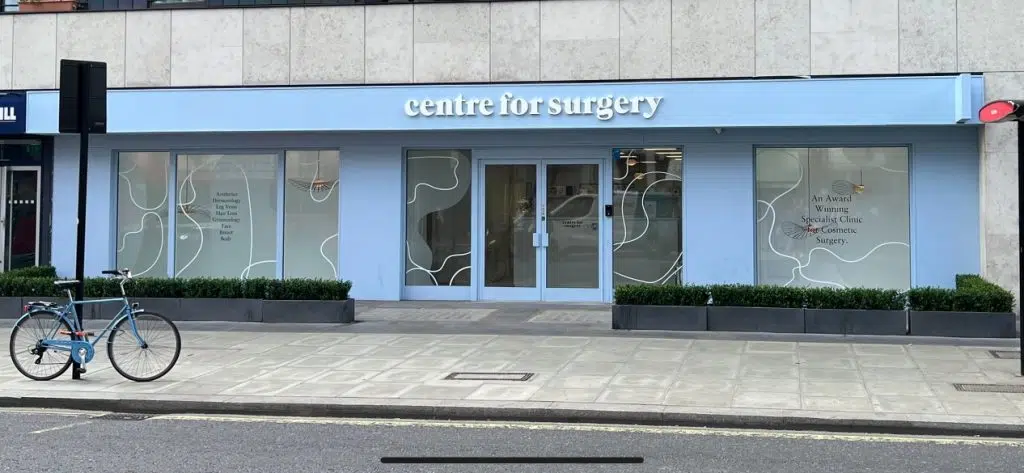Male breast reduction, also known as gynecomastia surgery, is a procedure to remove excess breast tissue and/or fat in men who have enlarged breasts. Gynecomastia is caused by various factors, including hormonal imbalances, obesity, and the use of certain medications.
The surgery is typically performed under general anaesthesia and can be done as an outpatient procedure. The surgeon will make an incision around the areola (the dark area around the nipple) and remove the excess tissue. In some cases, liposuction may also be used to remove excess fat. The incision will be closed with sutures or surgical tape. Here we discuss the risk of crater deformity after gynecomastia surgery.
RELATED: Gynecomastia Surgery FAQs – Q&As about Male Breast Reduction
What is a crater deformity?
A crater deformity is a complication that can occur after gynecomastia surgery (male breast reduction surgery). It is characterised by an indentation or “crater” in the chest area caused by an over-resection of tissue or improper healing after the procedure. This can occur when too much tissue is removed during the surgery, leaving a depression or hollow area in the chest. It can also happen when the skin doesn’t retract properly after the surgery, leaving a saggy or loose appearance. This can result in an unaesthetic and unnatural look of the chest area and can be difficult to correct. It is important for patients to have realistic expectations and for the surgeon to have a good understanding of the anatomy and use appropriate techniques to avoid this complication.
RELATED: How to Avoid Botched Gynecomastia Surgery
What Causes Crater Deformity After Gynecomastia?
Crater deformity after gynecomastia surgery is caused by the over-resection of tissue or improper healing after the procedure.
Over-resection of tissue occurs when too much tissue is removed during the surgery, leaving a depression or hollow area in the chest. This can happen if the surgeon is not experienced or not familiar with the patient’s anatomy, if the patient has unrealistic expectations or if the patient has an excessive amount of fat and glandular tissue that needs to be removed.
Improper healing can occur when the skin doesn’t retract properly after the surgery, leaving a saggy or loose appearance. This can happen if the skin is stretched or if there is poor healing or poor skin elasticity.
Other causes can include poor surgical technique, and postoperative complications like hematoma, seroma, infection, or improper wound healing.
In order to avoid this complication, the surgeon must have a good understanding of the patient’s anatomy and use appropriate techniques during the surgery. Clear communication and realistic expectations from the patient and the surgeon are also important.
How can a gynecomastia crater deformity be fixed?
A crater deformity can be corrected through revision surgery, which is usually done as an outpatient procedure, under general anaesthesia. The specific technique used to correct the deformity will depend on the cause of the problem and the individual patient’s needs.
One of the most common methods to correct a crater deformity is the use of fat grafting, also known as fat transfer. This involves taking fat from another area of the body, such as the abdomen or hips, and transplanting it to the chest area to fill in the depression or indentation. This technique can help to restore a more natural and smooth contour to the chest area.
Another option is using a dermal filler, which is a non-surgical approach and can be done under local anaesthesia. The dermal filler is injected into the depression area to fill the void.
Another option is to use a skin flap, which involves repositioning and moving a piece of skin from a nearby area to the crater area. The procedure will depend on the size, location and cause of the crater deformity.
Revision surgeries can be more complex than the initial surgery and may have more risks, and recovery time can be longer. You should consult with a specialist plastic surgeon who have experience in revision surgeries and has a good understanding of the anatomy and potential complications.
RELATED: What do gynecomastia scars look like?
Is revision gynecomastia surgery risky?
Revision gynecomastia surgery, also known as secondary gynecomastia surgery, is a procedure to correct or improve the results of previous gynecomastia surgery, including crater deformity. Like any surgery, revision gynecomastia surgery carries some risks.
Some possible risks include bleeding, infection, blood clots, anaesthesia complications, and poor wound healing. Additionally, there is a risk of dissatisfaction with the final results, as well as the possibility of additional revisions being necessary.
Revision surgery is usually more complex than primary surgery, and the risks may be higher. Therefore, it’s essential to choose a specialist plastic surgeon who has extensive experience in revision gynecomastia surgery.
Why Choose Centre for Surgery for Your Revision Gynecomastia Surgery?
If you’re considering revision surgery for gynecomastia, then you’ve already been through the stress of an initial procedure that didn’t give you the results you wanted. It’s crucial to make the right choice this time. That’s where Centre for Surgery steps in, offering not just medical procedures, but peace of mind.
Unrivalled Expertise
Our team of highly skilled surgeons has vast experience in performing revision gynecomastia surgeries. With years of expertise, they understand the nuances and complexities that come with a revision procedure. Our surgical techniques are cutting-edge, and we tailor our approach to meet the specific needs of each patient.
Patient Testimonials
Don’t just take our word for it; listen to our patients:
- John D.: “After an unsuccessful surgery elsewhere, the team at Centre for Surgery gave me back my confidence. My chest looks natural and I feel like myself again.”
- Michael S.: “Choosing Centre for Surgery for my revision surgery was the best decision I’ve made. The staff are caring, and the results are incredible.”
Individualised Treatment Plans
Your body is unique, and so should be your treatment. Our surgeons take the time to understand your specific concerns, challenges, and goals. Based on this, we create an individualised treatment plan aimed at achieving the best possible outcome for you.
In-Depth Knowledge
For more information on gynecomastia and revision surgeries, visit our Plastic Surgery Blog. Here, we delve into various topics, offering detailed insights and guidance to help you make an informed decision.
Book a Consultation Today
Ready to take the next step? Book a consultation to discuss your needs and evaluate your options.
📞 Phone: 0207 993 4849
📧 Email: contact@centreforsurgery.com
📍 Address: 95-97 Baker Street, London W1U 6RN
Choosing Centre for Surgery means opting for a team that brings unparalleled expertise, personalised care, and proven results to the table. Make the right choice for your revision gynecomastia surgery by trusting us to bring your aesthetic goals to life.











